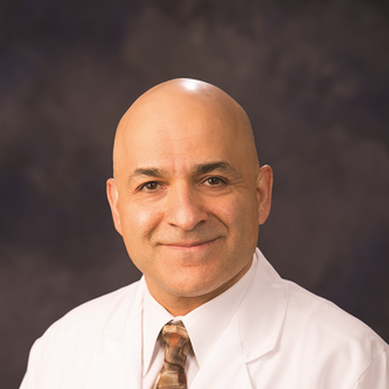A Remarkable Resilience

“The tumor was extremely small and I was put on medication for a few years,” Palafox recalls. “Then when I was 27 or 28, the headaches became excruciating.”
She was also experiencing blurred vision. Her primary care doctor ordered an MRI, which revealed that the tumor had doubled in size. Palafox was referred to Endocrinologist Mohamad Alnabelsi, MD, who switched her medication to reduce her prolactin level and shrink the tumor. Despite the new medication, symptoms did not improve, so Palafox was scheduled for surgery to remove the tumor.
“Knowing that you’re going to have what is essentially brain surgery is scary. I found out in early December [2008] that they wanted me to have it right away, but I wanted to spend the holidays with my family,” Palafox remembers.
On January 19, 2009, Board Certified Neurosurgeon Farhad Limonadi, MD, and Otolaryngology Head and Neck Surgery Specialist Syed Ahsan, MD, performed a transsphenoidal resection of the pituitary tumor. The procedure involves using a tiny endoscope to access the pituitary tumor through the nose and sphenoid sinus rather than a more invasive traditional craniotomy.
“Dr. Ahsan provided the approach and essentially put me at the wall of the sphenoid sinus,” Dr. Limonadi explains. “I was then able to use this as a corridor directly to the large tumor which was adjacent to the optic chasm and carotid arteries, without any brain manipulation.”
A transsphenoidal approach leaves no visible scar, bypasses brain tissue so that the risk of brain injury is very low, and enables faster recovery. Still, says Dr. Limonadi, the operation is complicated and requires a highly skilled surgical team to avoid damaging any crucial structures, such as the pituitary gland itself.

During the procedure, the team utilized stereotactic computer-assisted navigation, which provided three-dimensional imaging guidance to precisely map out the coordinates of Palafox’s brain, pituitary function and all critical structures, such as the carotid arteries.
The operation went smoothly, and Palafox spent a week in the hospital recovering before being discharged home, where she was able to resume her normal lifestyle quickly. Happily, a February 2022 MRI scan has shown no recurrence.
But the story doesn’t end there. Although Palafox was recovering well from the 2008 surgery, she complained of back pain in early February 2009 during a post-operative appointment with Dr. Limonadi. She was on pain medication, but it wasn’t helping. A thorough examination did not raise any red flags.
“She had no difficulty with her range of motion, she had no painful palpation or percussion of her back, her visual acuity was good,” recalls Dr. Limonadi. “She also didn’t show any signs of radiculopathy — no radiating pain, numbness or tingling along her legs.”
However, herniated discs often evolve to impinge on the nerves, and this is what Palafox started to experience. She went to the emergency department twice with back pain so severe that she had difficulty walking.
“I couldn’t do anything,” Palafox says. “It was hard getting out of bed, walking, driving — the back pain was constant, and I was literally disabled.”
A consult with Dr. Limonadi confirmed that the pain was now radiating through her left leg and an MRI scan detected a large, herniated disc on the left side of her lumbosacral joint. When pain management and other measures did not alleviate her suffering, she was once again scheduled for surgery.
“I was nervous, especially because I had had the brain surgery two months before, but I knew Dr. Limonadi was going to do it, I knew he was good and I knew he cared,” she says.
In March 2009, Dr. Limonadi performed a L5-S1 microdiscectomy, a minimally invasive procedure to take out the damaged disc and relieve pressure on her spine.
“Although it’s one of the simplest operations we perform as neurosurgeons, we don’t take it lightly. We approach it with the same level of detail as we do with complex brain operations,” says Dr. Limonadi, who emphasizes that one of the first steps to advance in neurosurgery training is mastering this operation.
With postoperative pain management, Palafox was able to walk the length of her hospital bed within 24 hours of surgery. She walked daily, determined to get home to her children as soon as possible. Within two weeks, Palafox was pain-free and able to resume all her normal activities.
Although back pain is very common, Dr. Limonadi emphasizes that it’s critical for physicians to make a correct diagnosis and exhaust conservative measures. If surgical intervention is required, patients should be approached in a way that minimizes injury and puts them back on the same trajectory of their lives.
Palafox looks back and points out how fortunate she was in terms of patient care and medical expertise.
“When you’re in so much pain and you’re told you have to have major surgeries, you need someone who makes you feel like a ‘person’ and Dr. Limonadi does that. He really cares, makes you feel comfortable and safe, and educates you on everything that is going to happen and why it needs to happen.”
“The biggest treasure in our lives is the influence we have on those we encounter,” says Dr. Limonadi. “It’s important not to take it lightly and to try to have a positive impact.”
To learn more about Eisenhower Neuroscience Institute,
visit EisenhowerHealth.org/Neuro or call 760-837-8020.



